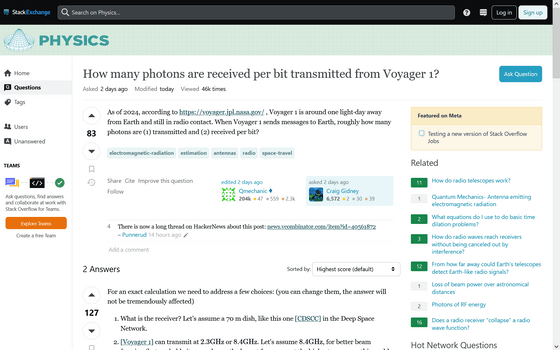How many photons per bit does Voyager 1 send and how many of them are received?

On June 1, 2024, a question about
Electromagnetic radiation - How many photons are received per bit transmitted from Voyager 1? - Physics Stack Exchange
https://physics.stackexchange.com/questions/816698/how-many-photons-are-received-per-bit-transmitted-from-voyager-1

The question posed was: 'As of 2024, Voyager 1 is about one light day away from Earth and is still communicating radio. When Voyager 1 sends a message to Earth, how many photons per bit are sent and how many of those are received?'
The questioner
The answer to the above question was given by theoretical physicist Jos Bergervoort, who gave the following answer assuming that the receiving side uses a 70m-class antenna, Voyager 1's transmission frequency is 8.4GHz, and that losses during transmission and reception are not taken into account.
Voyager 1 will transmit 160 bits of data per second, consuming 23 W of power, which at a frequency of 8.4 GHz translates to 4×10^24 photons per second, or roughly 2.6×10^22 photons per bit.

Voyager's antenna has a diameter of 3.7m, and it forms a beam to transmit radio waves mainly toward the Earth. The gain of this antenna is expressed as (πd/λ)^2, which allows it to focus radio waves efficiently. However, at the current distance from the Earth (R=23.5 billion km), the strength of the radio waves that reach it is only 3.4×10^(-22)W/m^2. Therefore, even if a receiving antenna with a diameter of 70m collects radio waves, it will only be about 1.3aW (1.3×10^(-18)W).
Dividing by Eφ, we can receive 240,000 photons per second, or 1,500 photons per bit. Voyager 1 uses 2.3 GHz in addition to 8.4 GHz, but if we were to use 2.3 GHz, the number of photons per bit would drop to 415. However, this is only a theoretical value, and when considering losses during actual transmission and reception, it would probably only be half this amount.
Related Posts:
in Posted by log1p_kr







